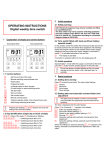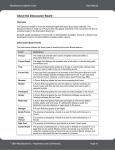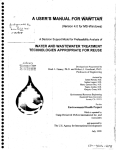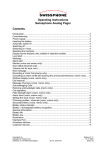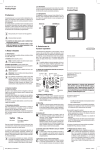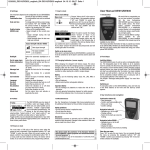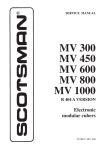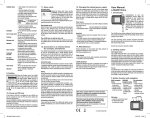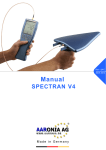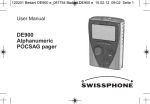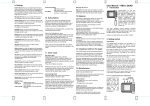Download PSW629 Manual -e- V2_04 - Paging & Wireless Service Center
Transcript
Programming Manual RE629 - V 2.04 copyright Swissphone Telecom Fälmisstr. 21 CH-8833 Samstagern Manual PSW629 AM SWION Art.No. 0991845 Page 1/28 V 2.04 / 06.08.2007 Contents 1. General information ........................................................................................3 2. Programming software PSW629 ....................................................................3 3. Programming station setup.............................................................................4 4. Programming notes ........................................................................................5 5. Installation ......................................................................................................6 6. First Steps ......................................................................................................7 6.1. Menu bar ........................................................................................................7 6.2. Toolbar ...........................................................................................................8 6.3. Considerations before setting up a program...................................................9 6.4. Structure of the Software................................................................................9 7. Configuring A Receiver...................................................................................10 7.1. Systems Tab...................................................................................................10 7.1.1. Configurations ..............................................................................................10 Tone System...........................................................................................................11 7.1.2. Info ...............................................................................................................11 7.2. Address Tab ...................................................................................................12 7.3. Options Tab ....................................................................................................15 7.3.1. Settings Pager Model ...................................................................................15 7.3.2. Settings System............................................................................................16 7.3.3. Settings Tone Decoder.................................................................................17 7.3.4. Miscellaneous...............................................................................................17 7.3.5. Settings Tones .............................................................................................20 7.3.6. Settings Timeouts.........................................................................................20 7.3.7. Menu ............................................................................................................21 7.3.8. Alerts ............................................................................................................23 7.4. File Info Tab....................................................................................................24 8. Setting the clock time .....................................................................................25 9. Set a password...............................................................................................26 10. Important notes...............................................................................................26 11. LIABILITY! ......................................................................................................27 12. Technical Data SGA Professional ..................................................................28 13. View of the SGA Professional ........................................................................28 copyright Swissphone Telecom Fälmisstr. 21 CH-8833 Samstagern Manual PSW629 AM SWION Art.No. 0991845 Page 2/28 V 2.04 / 06.08.2007 1. General information The Windows programming software PSW629 was developed to program the new RE629 generation of pagers. This software is not downward-compatible with the previous RE 429xx pager generation. The software recognizes RS232 Ports and USB-Serial converters. The PGM 300/429 programming adapter (now SGA Professional) has not been changed and can be used together with this software. The PSW629 software and Programming Guide can be obtained separately or in a complete programming set: Programming software PSW629 SW-Art.No. 0991 845 Scope of delivery: • CD with PSW629 programming software SW-Art.No. 0991 845 • The RE629 Programming Guide is available as a PDF file on the CD. Programming set for RE629 Scope of delivery: • SGA Professional programming adapter • RS-232 connection cable • CD with PSW629 programming software SW-Art.No. 0951 490 SW-Art.No. 0951 450 SW-Art.No. 0240 130 SW-Art.No. 0991 845 Option USB-Serial Converter SW-Art. Nr. 0240 135 Scope of delivery: • Converter Cable RS232 9-pol - USB, CD-ROM with Driver 2. Programming software PSW629 Features: • Read, change and program RE629 functions • Read-out of software and hardware configurations • Archiving of device configurations and programming parameters on your PC • Start test functions • Manage receiver passwords This Document uses colour to highlight passages that only apply to 2 Tone or 5/6 Tone devices. Anything highlighted in RED concerns 5 Tone receivers only, anything concerning 2-Tone receivers is marked GREEN. copyright Swissphone Telecom Fälmisstr. 21 CH-8833 Samstagern Manual PSW629 AM SWION Art.No. 0991845 Page 3/28 V 2.04 / 06.08.2007 3. Programming station setup The following components must be available and installed in order to program: IBM compatible PC: Pentium II (min 200MHz) 32MByte RAM RS232 interface or USB Mouse: required Supported operating systems: Windows 98SE Windows ME Windows NT Windows 2000 Windows XP Recommanded: Windows 2000 Windows XP RS 232 or USB copyright Swissphone Telecom Fälmisstr. 21 CH-8833 Samstagern Manual PSW629 AM SWION Art.No. 0991845 Page 4/28 V 2.04 / 06.08.2007 4. • • • • • • Programming notes Programming can be performed with or without a power source connected to the RE629. It is recommended to program with a battery! Connect the power supply of the PG programming adapter to a 230V mains socket. The amber, right hand, LED on the programmer indicates that the programmer is powered on. To install the software, place the CD in its drive and follow the instructions. If you receive an error message, repeat the installation. If necessary, deactivate antivirus software. Specify the PC port used in the programming software. The programming operation is indicated with a flashing green LED (left hand side). When the programming operation is completed, the pager resets and a beep can be heard. When reading device data with "READ" the LED flashes, and the pager resets too. As long as the pager is in the programming status, it shall under no circumstances be removed from the programming adapter. (If necessary, send a reset command). A short interruption can already lead to EPROM corruption. Therefore please check that the contacts on both pager and programming adapter are clean before programming. Erroneous data packages lead to an interruption in the programming procedures and you will have to re-write the configuration once more. SWISSPHONE is not liable for incorrect programs, for programs that violate the regulations of the BOS or any other network operators or for any damage resulting from such programs. copyright Swissphone Telecom Fälmisstr. 21 CH-8833 Samstagern Manual PSW629 AM SWION Art.No. 0991845 Page 5/28 V 2.04 / 06.08.2007 5. Installation Place the CD in its drive and follow the instructions. If need be, start the SETUP.EXE file. You can start the software by double-clicking on the file name PSW629.EXE, or you can start it directly using the desktop icon. For the use of the normal version of the PSW it is not necessary to order a code! The PSW629 normal version allows to implement all network-relevant programming functions. These functions permit you to program pagers or store configuration the data on a media or print it out. However, it is not possible to change any service settings. Service-Version: The service version [Serv629.exe] is only available on a separate CD and must be enabled by registration). To receive this registration authorisation, you need to attend a service course or a permission from Swissphone. After start-up, the software generates a CODE unique to your computer which is displayed on the screen as "Modifier". Transmit this code to SWISSPHONE via E-mail [email protected] or Fax +41 (0) 44 786 7771 You will receive the serial number and password for your programming PC from SWISSPHONE. Enter these in the appropriate fields. The service version is subsequently enabled. You can start the service version after enabling it by double-clicking on the file "Serv629.exe", or you can start it directly by double-clicking on the shortcut on the Windows desktop. Remark: Future upgrades will not require the input of a password on this computer. However, you will need a new password to install the software on another computer. copyright Swissphone Telecom Fälmisstr. 21 CH-8833 Samstagern Manual PSW629 AM SWION Art.No. 0991845 Page 6/28 V 2.04 / 06.08.2007 6. First Steps 6.1. Menu bar In the menu bar, there are main menus with submenus like those conventionally used in Windows applications. File New Opens standard file RE629 (depending on type) Open... Opens the file Save... Saves the current settings to the PC Save as... Saves the current settings under a new name on the PC Print Settings… Configure the printer and select if addresses, options or both are printed Print Prints the active *.629 file Exit Exit the program The lower section displays the last files used including their paths. The files can be loaded directly from there. Pager Read Read the data from the pager Reset Resets the pager Write Write the data to the pager Options Language Selection: German, English, French, Italian Com Select the correct port Show Info Messages Show info text Ton Systems Preconfiguration of Tone lengths and Frequencies (5/6 Tone only) copyright Swissphone Telecom Fälmisstr. 21 CH-8833 Samstagern Manual PSW629 AM SWION Art.No. 0991845 Page 7/28 V 2.04 / 06.08.2007 Windows Tile Arrange open windows side-by-side Cascade Make all windows visible Arrange Icons Arrange minimised windows Help About Information about the manufacturer and version 6.2. Toolbar The symbols on the toolbar are for the following functions: Create new pager configuration (for either 2 or 5/6 Tone devices) Open File Ctrl + O Save File Ctrl + S Print File Ctrl + P Read Data Ctrl + R Reset Pager Write Data Ctrl + W Activate Service Menu Password Set and change a password Set language Port settings copyright Swissphone Telecom Fälmisstr. 21 CH-8833 Samstagern Manual PSW629 AM SWION Art.No. 0991845 Page 8/28 V 2.04 / 06.08.2007 6.3. Considerations before setting up a program The RE629 is available in different model variants: Tone, Voice and Memo, Singlechannel, Multi-channel and so on. Each of these pagers is available as either 2-tone or 5/6-tone devices. Please understand that 2 / 5 Tone is a Manufacturing option and the receiver has to be ordered for the correct system. A later change of the tone system is not possible. The models Voice and Memo have the option to use profiles. The conventional, switchable addresses used with the RE429 are no longer supported. In idle state, the active profile is always recognisable. This is to ensure that the receiver is not set to the wrong channel or configuration unintentionally. Additional profiles can be programmed at a later date without deleting the existing programming. The memory capacity is adequate for 32 addresses (when a control call is uses 31 + control call address). This makes it possible to store complete organisational structures "in stock" in the memory. Only the currently required addresses are activated. Thereby change can be effected with minimal effort and unbureaucratically. You can use profiles to change the alarm tones. To do this, create a duplicate of the desired address and activate this in the new profile. Enter a different alarm tone in this profile. After the user switches over to the new profile, the addresses remain active, but the alarm tone is different. (e.g. without a tone) 6.4. Structure of the Software The software is structured in four "Tabs" to switch between tabs, simply click with your mouse on the desired tab at the bottom of the screen. These tabs are available: System: profiles / channels and tone system parameters Address: enter and configure addresses Options: define how the receiver can be operated File Info: enter information regarding the file Sometimes the "tabs" are also called "sheets" or "registers". copyright Swissphone Telecom Fälmisstr. 21 CH-8833 Samstagern Manual PSW629 AM SWION Art.No. 0991845 Page 9/28 V 2.04 / 06.08.2007 7. Configuring A Receiver 7.1. Systems Tab Areas highlighted red concern 5/6 tone devices only! 7.1.1. Configurations 50 configurations are available. The user can switch/select any of the configurations on the pager. For the single channel receiver, the frequency is always the same, the configurations serve as profiles. A multiple channel device can store up to 50 channels, each with its accompanying settings. To use profiles with a multi channel unit, simply enter the same frequency twice with a different name (e.g. Ch1A, CH1b). Enter the receiver frequency of the device here. With onechannel devices, enter the same frequency for each configuration. When you hit "Enter" after entering a "Mark" Frequency the Frequency will be copied into the next configuration. With multi channel devices, please pay attention to the switching range. Profile The characters entered here will be displayed when the pager is ready to receive. This serves too remind the user of the current setting. For single channel units which do not use profiles it is best to leave this empty. copyright Swissphone Telecom Fälmisstr. 21 CH-8833 Samstagern Manual PSW629 AM SWION Art.No. 0991845 Page 10/28 V 2.04 / 06.08.2007 S Frequencies that are checked in this column, will be scanned (form top to bottom). Tone System Only applies to 5/6 tone receivers! After selection of a tone system, the tables display the tone names (1…G), frequencies and tone lengths along with their tolerances. The tone lengths and the tolerances can be changed, if necessary (Tone System "free"). Please weigh the consequences seriously before you change any settings here. The following applies to BOS radio networks: ZVEI I Tone length The parameters of the receiver are entered here. The length of every tone can be individually set. The same applies to the tolerances. Tone Table The frequencies of the tones can be entered here. There are 16 fields available. TonelengthMonitoring Standard A: Highest sensitivity If no net-standard transmission is used or to reach a higher reliability the selection B to D can be used. 7.1.2. Info After read-out of a receiver, the relevant data is available here: Type Model version Serial Serial number Order Sequence number of the customer order Print / Rep Print and service information Band Mechanical tuning range Modulation Channel spacing: (10/12.5; 20; 25 kHz) Demodulation: (FM; PM) FW Version of the firmware Prod Sequence number of the production lot Tuning Freq Tuning frequency Switch Range Switch range Remark: The contents of these fields can not be modified. copyright Swissphone Telecom Fälmisstr. 21 CH-8833 Samstagern Manual PSW629 AM SWION Art.No. 0991845 Page 11/28 V 2.04 / 06.08.2007 7.2. Address Tab In the tab "Address", the settings for the address may be defined. This also includes the alarm type. If you move the mouse pointer briefly over a field, a small help text is displayed. Begin each new line with the entry of the call address (Tone 1, Tone 2). Address sheet for 2-Tone receivers (anything concerning only 2-Tone is GREEN) Address sheet for 5/6 Tone receivers (anything specific to 5/6 Tone is RED) copyright Swissphone Telecom Fälmisstr. 21 CH-8833 Samstagern Manual PSW629 AM SWION Art.No. 0991845 Page 12/28 V 2.04 / 06.08.2007 Mark The designation entered here will be shown in the display of the pager when a call is alerted or retrieved. There are several characters from which to choose from. Longtone: L No: This address has 2 tones. Yes: This address has one long tone. Tone 1 Tone 1 of address. Enter the tone frequency in hertz. Tone 2 Tone 2 of address. Enter the tone frequency in hertz. Code Grp For 5/6 Tone receivers start here by entering the address Associates the call indicator groups A, B, C, D (as viewed from the top of the display). These blink when an address has been sent an alarm and remain visible until the call is acknowledged. No: Prio The pager's settings control the alarm setting associated with the address (Loud; Quiet; Silent). Yes: This address will always emit a loud alarm. Type Type of alarm used: Tone. Alarm tone, no voice message .Tone & Voice. Alarm tone, then voice message .Voice. No wake tone, but voice message output immediately The default duration of the wake tone signal is 5 seconds. The duration can be changed to a value from 1 to 30 seconds in "Rep". VoiceMem Only for pagers "Memo": For every address to fix if the messages are: - never recorded "none" - recorded on a reserved memory "fix" - recorded on the next free open memory "dynamic" Beep An acoustic alarm melody is used to alert this address. Enter in the number here. Compose the acoustic alarm melody in Options \ Alarming. Rep The acoustic alarm melody of this address is repeated. Enter in here the number of times the acoustic alarm melody is to be repeated. The duration of one cycle is approx. 1 second. Pause: between the melody's repetition cycles. P No: without pause Yes: with pauses copyright Swissphone Telecom Fälmisstr. 21 CH-8833 Samstagern Manual PSW629 AM SWION Art.No. 0991845 Page 13/28 V 2.04 / 06.08.2007 2. The alarm signal continues to be emitted as long as the 2nd tone (or the long tone) is detected. The Charger's Mask (CM) defines the behaviour of the pager when in the charging unit. If set to "Switched OFF" (CM, red), then the behaviour of the pager is the same whether it is in the charging unit or not. If set to "Switched ON" mode (CM, green), then the following behaviour options are available: CM No: The pager will not issue alarms for this address when in the charger. Yes: The pager will issue alarms for this address when in the charger as per its settings. Loud: The pager always issues a LOUD alert when in the charger even if the pager setting is QUIET. E The user can select between pre-set profiles. In addition to this selection, the Extra profile can be switched ON/OFF at any time. Use this columns to e.g. organise a standby service at irregular intervals. Attention: TR-BOS will not allow switching of addresses. ChXX Coding Option Ch1A etc. are just examples of a profile names. The names are assigned in System/Configuration, in the column "Profile". The addresses that are desired may be activated in each of the profiles. The user can switch between profiles on the pager. If a profile is assigned a frequency which is different from the current operational frequency, the receiver will switch to the new frequency when the profile is changed (on the receiver) This applies only to multi channel units! If no profiles are activated (all names are red), then all defined addresses are active. Attention: TR-BOS will not allow switching of addresses. On 2 Tone devices this allows you to use simpler entry forms, such as "A-B, Long A". copyright Swissphone Telecom Fälmisstr. 21 CH-8833 Samstagern Manual PSW629 AM SWION Art.No. 0991845 Page 14/28 V 2.04 / 06.08.2007 7.3. Options Tab In the tab sheet Options, define the user controls and general settings of your receiver. 7.3.1. Settings Pager Model You can find your Pager's model in the "System" Tab, Info Tone: The pager works as a "Tone" Model, even if it actually is a model that supports features of a higher model Pager Model Eco: The pager works as a "ECO" Model, even if it actually is a model that supports features of a higher model copyright Swissphone Telecom Fälmisstr. 21 CH-8833 Samstagern Manual PSW629 AM SWION Art.No. 0991845 Page 15/28 V 2.04 / 06.08.2007 Voice: The pager works as a "Voice" Model, if the hardware / firmware is equipped as necessary. But will not work as a higher model, even if the hardware / firmware would support it. Memo:The pager works as a "Memo" model, if the hardware / firmware is equipped as necessary Single Channel: The receiver can be programmed to one frequency in the range of +/- 500 kHz form the tuning frequency. A single channel device can not b programmed to behave as multi channel unit. Receiver Type Multi Channel: The receiver can be programmed to up to 50 frequencies and will receive on the frequency that is associated with the currently active configuration. Scanner: The receiver is able to scan through multiple channels sequentially. The network has to send out a scan criteria (long first tone or carrier) to ensure that all alerts can be detected. A criteria must be sent for at least 125ms per scanned channel. 7.3.2. Settings System Ctrl. Call Addr. To use "Group Calls" please add K's after the tonest hat are identical. Example: 513KK There are various options for the receiver to recognise the radio network. The basic functionality is set here: No: Net monitoring Yes: Network detection is switched on. Other settings can be input. If no monitoring functions are activated, only the pager's own addresses are accepted for network detection. No: Carrier Carrier detection is switched off. Yes: detecting a carrier is considered, "Network OK" No: Control Call Network detection is switched off. Net monitoring does not us a control call. Yes: A specific address must be cyclically received in order for a radio network to be accepted as the "home network". The call address is entered like described above by " Ctrl. Call Addr" Control tone A specific tone must be cyclically received in order for a radio network to be recognised as the "home network" (pilot tone). Warning When a gap in radio network communication occurs, an antenna symbol appears in the display as a first warning. The time delay between network detection and warning can copyright Swissphone Telecom Fälmisstr. 21 CH-8833 Samstagern Manual PSW629 AM SWION Art.No. 0991845 Page 16/28 V 2.04 / 06.08.2007 be entered in the field to the right. Alert If communication with the network is still absent after a warning has been issued, then an alarm is triggered and a beep tone is sounded. The time delay between warning and alarm can be entered in the field to the right. Only for "Voice, Memo": No: Inverted Segment The field strength symbol is displayed if there is "no Network" Yes: The field strength symbol is displayed if a network was detected No: Chrg. Unit Alert receiver will not issue "No Network Alerts" if inside the charger Yes: receiver alerts normally even in the charger No: Alert Repetition The alarms as set by "Alert" are only once signalized. Yes: The alarms as set by "Alert" are repeted. No: Accustic Alert Accustic alerts are never signalized Yes: All alarms as set in the pager are signalized No: The message is transmitted without delay Yes: The message is transmitted with the criterias: Control Call (recommanded) Carrier frequency End of call (addresses have to start identical) Time as set above Delayed Message 7.3.3. Settings Tone Decoder Applies to 2 Tone only Timing Standard: for address tone decoding suited to most networks. Fast: for address tone decoding suited to fast networks. 7.3.4. Miscellaneous No: Vibrator copyright Swissphone Telecom Fälmisstr. 21 CH-8833 Samstagern The vibrator is never operative. Yes: The vibrator functions in accordance with the following settings: Manual PSW629 AM SWION Art.No. 0991845 Page 17/28 V 2.04 / 06.08.2007 No: It functions, but not in the charging unit Yes: It functions in the charging unit as well Beeper Rechrg batt Voice Memory Standard: Fast: Choose if a nickel cadmium battery or a metal hydride battery is used Only for Memo pagers: The analogue memory can be divided in "partitions". Define the number and size of each partition. An incoming call always utilizes an entire partition. No: Switch Off Squelch delayed Alarm Timer Push to Listen Message overview Alert ack Voice on The time since the message was received is not shown on the display Yes: The time since the message was received is shown on the display No: Stop REC by Receipt Relay Control The receiver is switched of directely after the message Yes: The receiver remains about ½ second longer open to receive No: Watch The receiver can not be switched off using the keys. (Continuous operation) Yes: The receiver can be switched off using the keys. No: Standard Volume The duration of one cycle is approx. 1 second. The duration of one cycle is approx. 0.5 seconds. It is not possible to interupt the recording Yes: The recording can be interupted Upon inserting a Battery this volume setting will be applied No: Watch and Timestamp are not active Yes: Watch is active, timestamp may be activated Alarm Cont: Relay is activated for 5 Sec upon alarm AF Control: Relay is activated when speaker is active Yes: In "Silent" mode the channel may be opened by pressing the right hand button after an alarm A graphical overview of received calls is displayed when retrieving. A call in Group A corresponds to a dash in the first column of the display. Three dashes mean 3 or more calls in one Group (A, B, C, or D) No: when acknowledging a call while the receiver is still beeping, the voice message will not be heard copyright Swissphone Telecom Fälmisstr. 21 CH-8833 Samstagern Yes: when acknowledging a call while the receiver is still beeping, the voice message will still be heard. To silence the voice message press Manual PSW629 AM SWION Art.No. 0991845 Page 18/28 V 2.04 / 06.08.2007 "right" once more. 5 Tone devices show the same behaviour when "delayed message" is activated! Scanner Priority Channel. : All selected channels are scanned in order : The first channel is the Priority Channel. After receiving an alarm on a "non priority channel" the receiver will check the priority channel regularly. This way you will not miss any alert on the priority channel. Preamble: Address decoding is started after the receiver detects a valid preamble. The control tone (System-Tab -> Tonetable) is used as the preamble tone. Criteria First Tone: In case the first address tone is long enough, it may be used as scan criteria. For each channel you want to scan, the tone needs to be prolonged 125ms (250ms for two channels). Squelch: With this option, carrier detection is used as scan criteria. Attention: the receiver may be "locked to one channel" when a carrier is on air! If you use your receiver for alerting purposes, we strongly recommend, to use one off either "Preamble" (5-Tone only) ore "First tone" for your scan criteria. Preamble: Define the length of the preamble as sent by the system. (Has to be >125 times "number of channels). In case the preamble is longer than the minimum, your standby time will be increased. copyright Swissphone Telecom Fälmisstr. 21 CH-8833 Samstagern Manual PSW629 AM SWION Art.No. 0991845 Page 19/28 V 2.04 / 06.08.2007 7.3.5. Settings Tones No: Buttons No sound is emitted when pressing a key. Yes: A click sound is emitted when pressing a key. No: Power Off No warning sound is emitted. Yes: A warning sound is emitted when switching off. No: Power On No control beep is emitted. Yes: A control beep is emitted when switching on. (Loudspeaker OK) 7.3.6. Settings Timeouts No: Call Reminder A reminder will not be issued for missed alarms. Yes: A reminder will be issued for alarms that are not acknowledged. A warning tone is sounded. The number of reminders and the time interval between reminder tones can be set. Call Suppression Call suppression detects alarms occurring on the same address within a specified time period. The same address will not be sent an alarm again within this time period. Call suppression starts counting the time since the last call was received. Squelch A message is understood to be ended when the squelch timeout has expired. A new signal received within this time period is interpreted as a continuation of the last message. In this way, fading and radio reception gaps can be bridged. Recommendation: 1 second Warning: DS squelch timeout must be supported by the radio network! (Pause between calls) copyright Swissphone Telecom Fälmisstr. 21 CH-8833 Samstagern Manual PSW629 AM SWION Art.No. 0991845 Page 20/28 V 2.04 / 06.08.2007 7.3.7. Menu The operating functions can be activated ( ) and arranged in any desired order. To do so, use the "Drag & Drop" function of your mouse. No: Loud alerting can not be selected. Yes: Loud alerting can be selected. Loud Alert Note: At least one of the options activated. No: must be Quiet alerting can not be selected. Yes: Quiet alerting can be selected. Discrete Note: At least one of the options activated. must be Silent alerting: Only LED, LCD and vibrator signals are emitted. No: Silent alerting can not be selected. Yes: Silent alerting can be selected. Silent Note: At least one of the options activated. must be Monitor mode: Every radio signal activates the loudspeaker. The alarming of addresses remains unaffected and functions as usual. No: Monitor Monitor can not be selected. Yes: Monitor can be selected. Note: At least one of the options activated. must be Volume of the voice message is adjustable. No: Volume Volume can not be adjusted. Yes: Volume can be adjusted. Enables an artificial subdivision of the menu. Normally, the user only has access to the operation controls of the above listed functions. The functions listed below can be accessed by pressing and holding the left-hand key for more than 3 seconds. This simplifies navigation when performing extensive programming. Only for Memo pagers: No: Stored messages Saved voice messages can not be listened to. Yes: Saved voice messages can be listened to. Only for Memo and Voice pagers: No: Act out of range copyright Swissphone Telecom Fälmisstr. 21 CH-8833 Samstagern Field strength symbol if no field is received. Yes: Field strength symbol if field is received. Manual PSW629 AM SWION Art.No. 0991845 Page 21/28 V 2.04 / 06.08.2007 Set Time No: Time can only be set using the PSW Yes: Time may be set on the device itself Set Time Change the active Profile Profiles No: Profil / Channel can not be changed Ja: Profil / Channel can be changed on the device Scanner only: Scanner Allows to enable/disable scanning mode on the receiver. copyright Swissphone Telecom Fälmisstr. 21 CH-8833 Samstagern Manual PSW629 AM SWION Art.No. 0991845 Page 22/28 V 2.04 / 06.08.2007 7.3.8. Alerts You can compose the alarm "melodies" yourself. To do so, first define the 3 different pitches (A; B; C), which will form the basis for the melody pattern. Please note that, due to the construction of the human sense of hearing, the volume and tone frequencies will be perceived differently by each person. Certain tone frequencies may be selected which will enable persons with hearing limitations to receive audible alarms. From a technical standpoint, the loudest sound is produced at a frequency of 2300 Hz. Frequencies Enter in the 3 possible tone frequencies. The lower the value, the more bass the sound. The range spans between 300 and 3000 Hz. Patterns You may compose up to 8 tone patterns (1 in each line). Beeper Enter in the tones A; B; C in the sequence in which you would like them to be heard. A minus sign "-" creates a short pause. LED "1" switches on the red LED, "0" switches the LED off. It is helpful for the user if the LED pattern is accompanied by the tone pattern. Vibrator "1" switches on the vibrator, "0" switches it off. A rhythmic cycle of the vibrator is more conspicuous than continuous operation. copyright Swissphone Telecom Fälmisstr. 21 CH-8833 Samstagern Manual PSW629 AM SWION Art.No. 0991845 Page 23/28 V 2.04 / 06.08.2007 7.4. File Info Tab The information contained in this tab are only stored inside the *.629 file, not the receiver. You may use this form freely e.g. to store costumer data. copyright Swissphone Telecom Fälmisstr. 21 CH-8833 Samstagern Manual PSW629 AM SWION Art.No. 0991845 Page 24/28 V 2.04 / 06.08.2007 8. Setting the clock time (only for Voice and Memo) The clock time is automatically transferred during a programming session from the PC system time. The clock time can also be set at the receiver (see user manual of the receiver). It is also possible to set the clock time in the "service dialogue"; "Set Time" is setting the PC system time on the receiver: copyright Swissphone Telecom Fälmisstr. 21 CH-8833 Samstagern Manual PSW629 AM SWION Art.No. 0991845 Page 25/28 V 2.04 / 06.08.2007 9. Set a password To protect the user data of a receiver it is possible to set a password (choose "password" in the toolbar). The receiver is already protected during reading out. If the password is not available, it is possible to set a new one; hereby all user data are getting lost (programming file reset)! If a receiver is coming without password into a repair center, it is only possible to reset in this way. If no password should be used any more, read out the receiver, save the programming file, and let the field empty "new password" and "confirm". 10. Important notes There is an abundance of security features in the programming software that output clear information and warnings to ensure that the RE629 pager programming functions properly. These features react to incorrectly defined parameters and request the user to check and correct the parameters. Warnings are output when incorrect parameters, ranges, times or function links are selected. The programming of incorrect parameters is hereby deterred. Only a part of the errors due to incorrect variable values, which could lead to improper function in the radio network, can be discovered beforehand. Only software-related functions can be programmed. The hardware in the device cannot be changed by the programming. • The programming operation is indicated with a flashing green LED. When the programming operation is completed, the pager resets and the power can be heard. When reading device data with "READ" the LED flashes, and the pager resets too. As long as the pager is in the programming status, it shall under no circumstances be removed from the programming adapter. (If necessary, send a reset command). A short interruption can already lead to a E-PROM corruption. Therefore please check that the contacts on both pager and programming adapter are clean before programming. copyright Swissphone Telecom Fälmisstr. 21 CH-8833 Samstagern Manual PSW629 AM SWION Art.No. 0991845 Page 26/28 V 2.04 / 06.08.2007 ATTENTION! The original programming software is specially marked, and SWISSPHONE reserves the right to make changes to this software. When a new version of the software is installed, the old version should not be used anymore. 11. LIABILITY! SWISSPHONE is not liable for incorrect programs, for programs that violate the regulations of the BOS or any other network operators or for any damage resulting from such programs. copyright Swissphone Telecom Fälmisstr. 21 CH-8833 Samstagern Manual PSW629 AM SWION Art.No. 0991845 Page 27/28 V 2.04 / 06.08.2007 12. Technical Data SGA Professional SGA Professional: Power supply: Frequency: Secondary voltage: Power supply plug: Standards: Plug-in power supply, AC 230V +/-10% 50/60 Hz DC 12.6V / 450mA, unregulated. Euro-plug: CH, Germany, F, Scandinavia, among others SEV, VDE, DEMKO, SEMKO, etc. Monitor LED: Amber LED = DC supply Green LED = data flow Ports (interfaces): DIN socket RS -232, 9-pin, female 13. View of the SGA Professional Control – LED Programming – LED Rx/Tx Data in Data Out RS 232 ATTENTION: The programming adapter PG Professional is not a charging unit. copyright Swissphone Telecom Fälmisstr. 21 CH-8833 Samstagern Manual PSW629 AM SWION Art.No. 0991845 Page 28/28 V 2.04 / 06.08.2007





























